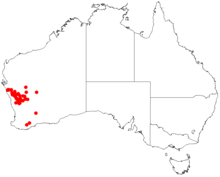Darwinia capitellata
Darwinia capitellata is a plant in the myrtle family Myrtaceae and is endemic to the south-west of Western Australia. It is a bushy, many-branched shrub, very similar to Darwinia diosmoides but differs in the arrangement of its flowers, its more branched habit, prominent oil glands on the younger stems and its thinner, paper-like bracteoles. It was first discovered as a separate species when specimens of it were found to have a larger chromosome number than specimens of D. diosmoides.
| Darwinia capitellata | |
|---|---|
| Scientific classification | |
| Kingdom: | Plantae |
| Clade: | Tracheophytes |
| Clade: | Angiosperms |
| Clade: | Eudicots |
| Clade: | Rosids |
| Order: | Myrtales |
| Family: | Myrtaceae |
| Genus: | Darwinia |
| Species: | D. capitellata |
| Binomial name | |
| Darwinia capitellata | |
 | |
| Occurrence data from AVH | |
Description
Darwinia capitellata is a many-branched shrub growing to 1.0 metre (3 ft) high with its leaves crowded near the ends of the branches. The younger branches have prominent oil glands. The leaves have distinct oil glands, a distinct stalk and are 2.5–4.5 millimetres (0.1–0.2 in) long and 0.5–1.0 millimetre (0.02–0.04 in) wide.[2]
The flowers are arranged near the ends of the branches in heads that are more corymb-like than those of other species of Darwinia. The two bracteoles around each flower are 2.3–4.0 millimetres (0.09–0.2 in) long, 0.5–1.0 millimetre (0.02–0.04 in) wide, thin and papery and fall off as the flower matures. The petals are egg-shaped, white 1.8–2.3 millimetres (0.07–0.09 in) long and enclose the 10 stamens, staminodes and the lower part of the style. The style which protrudes from the rest of the flower is 4–6 millimetres (0.16–0.24 in) long and has a band of hairs near its tip. Flowering occurs between August and November and is followed by the fruit which is a non-fleshy nut containing a seed 1 millimetre (0.04 in) long.[2]
Taxonomy
The description of Darwinia capitellata was published in 1983 in Nuytsia by Barbara Rye, the first publication of a new species by the prolific taxonomist.[3] The type specimen was collected by Charles Gardner near Paynes Find.[1] It was first recognised as a distinct species when some specimens were found to have 12 chromosomes, rather than the usual 7 or 14 for Darwinia diosmoides, evidence that was later confirmed by comparison of their morphology.[3] The specific epithet (capitellata) is from the Latin word capitatus with the diminutive ‑ell‑, hence meaning "forming a small head",[4] referring to the arrangement of the flowers in this species.[2]
Distribution and habitat
This darwinia grows on sandplains, sometimes on sandstone rock between Kalbarri National Park, Perenjori and Sandstone in the Avon Wheatbelt, Geraldton Sandplains, Mallee, Murchison and Yalgoo biogeographic regions.[2][5][6]
Conservation
Darwinia capitellata is classified as "not threatened" by the Western Australian Government Department of Parks and Wildlife[5]
References
- "Darwinia capitellata". APNI. Retrieved 12 September 2016.
- Rye, Barbara Lynette (1983). "Darwinia capitellata (Myrtaceae), a new species from south-western Australia". Nuytsia. 4 (3): 423–426.
- Thiele, K. (May 2019). "Post "The amazing Dr Rye"". Taxonomy Australia. Australian Academy of Science.
- Francis Aubie Sharr (2019). Western Australian Plant Names and their Meanings. Kardinya, Western Australia: Four Gables Press. p. 157. ISBN 9780958034180.
- "Darwinia capitellata". FloraBase. Western Australian Government Department of Parks and Wildlife.
- Paczkowska, Grazyna; Chapman, Alex R. (2000). The Western Australian flora : a descriptive catalogue. Perth: Wildflower Society of Western Australia. p. 359. ISBN 0646402439.